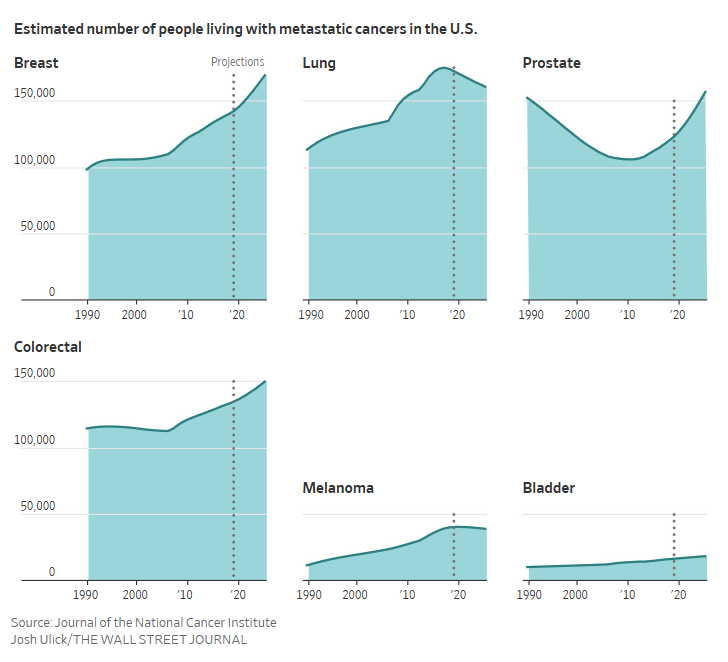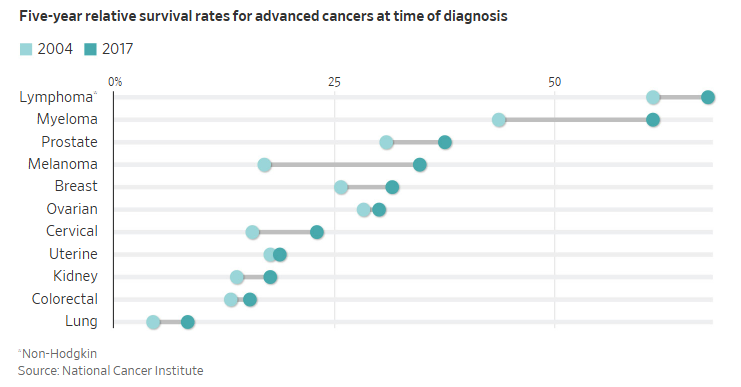The Changing, Extended Life with Terminal Cancer
I saw it with my late husband Stu -- I understand the hope and the fear
17 Aug 2025, WSJ: A New Reality for Terminal Cancer: Longer Lives, With Chronic Uncertainty
Gwen Orilio didn’t know how long she had to live after her stage-four lung cancer diagnosis. The disease had already infiltrated her eye, so the 31-year-old didn’t bother opening a retirement account.
Ten years later, Orilio is still alive. And she still has metastatic cancer.
Keeping her going is a string of new treatments that don’t cure the disease but can buy months—even years—of time, with the hope that once one drug stops working a new one will come along. Orilio started on chemotherapy, and then switched to a new treatment, and then another, and another, and another.
“What’s next? What do I have lined up for when this one stops working?” said Orilio, a high-school math teacher who lives in Garner, N.C. “My motto is that the science just needs to stay a step ahead of me, and so far it’s been working.”
This past winter, she started a retirement fund at age 41.
Orilio is part of a new era of cancer treatment challenging the idea of what it means to have and survive cancer. A small but growing population is living longer with incurable or advanced cancer, navigating the rest of their lives with a disease increasingly akin to a chronic illness. The trend, which started in breast cancer, has expanded to patients with melanoma, kidney cancer, lung cancer and others.
I’m going to step in to explain the structure of these stories for a moment, because I do find them a bit annoying. Yes, I understand why the journalists use this structure.
They always start with a specific person… who they carefully selected for their particular angle. That person is going to have the story arc they want to pursue.
In this case, it’s someone who has an incurable, but treatable, cancer.
And who is still alive. That is somewhat important. Being dead would undercut the story they want to tell. I am not going to follow this person further, as it’s the WSJ’s story. I’m more about the stats.
That said, this is a real story, because I saw this happen with my late husband Stuart. But he did die from his cancer, because it was a matter of living until either his cancer or the chemo killed him… and it was the cancer.
A retrospective: 7 years, likely 6 years beyond original expectation
My husband died on September 30, 2024. So that anniversary is coming soon.
He had been diagnosed with metastatic prostate cancer in August 2017.
It was not curable, but it was treatable. At the time, the cancer had spread throughout his body, and the scans “lit up like a Christmas tree.”
I had made the mistake (compounded by a relative w/ medical links) of looking up survival statistics for that diagnosis.
1 year: 50%
5 years: 2%
Now, these were based on older patient cohorts, in two aspects:
The men tended to be 20+ years older than Stu was when diagnosed (usually 75+ years old, like Biden was when diagnosed)
The patients being treated were from a group of patients over the last 20 years… and there were newer treatments available now
These two items were extremely relevant in Stu’s survivorship. In talking with the oncologists, the new treatments had just been coming online, and many had been developed due to advancements in treating metastatic breast cancer.
One issue, of course, is that a lot of cancer treatments can be harsh. So older patients generally could not survive the treatments — we were told that the cancer was still not curable, but treatable, and the issue was chronic treatment such that either the cancer, or the chemo treatment, would eventually kill the patient.
Back to the WSJ article.
The Pattern of Cancer History in the U.S.
More than 690,000 people were projected to be living with stage-four or metastatic disease of the six most common cancers—melanoma, breast, bladder, colorectal, prostate or lung cancer—in 2025, according to a 2022 report from the National Cancer Institute. That’s an increase from 623,000 in 2018 and a significant rise since 1990, the report found.
There are multiple ways to end up being counted as living with metastatic cancer.
You had non-metastatic cancer (the point at which it was detected)… and sorry, bad luck, your cancer spread. Maybe you were being treated, maybe you weren’t, whatever.
Your cancer wasn’t detected until it was metastatic (this is what happened to Stu). You are still surviving.
The reason I mention the different reasons for metastatic cancer counts, is because I think part of the reason for the rise in metastatic prostate cancer is the change in screening protocols.
Survivorship Changes
Let’s take the above statistics as given. The percentages I gave above are lower than seen here — but probably came from much older papers. Also, these are relative survivorship, which is based on the underlying survivorship probabilities. Once you get over age 60, it’s starting to dig into serious death probabilities.
In general, “advanced” cancer is not curable. If cancer gets into your bones, with our current medical treatments, we don’t have a way to eradicate it. It can still be treatable. You can still improve your odds, if you have advanced cancer.
Heck — they’re only showing 2004 and 2017 here. If they showed much earlier years, the survivorship percentages would be MUCH worse.
We’ve made a huge amount of progress in treating cancer.
Video: On Cancer Mortality Trends
I had recently talked about mortality trends (and morbidity — aka getting ill) with the Insurance Collaboration to Save Lives, and I tried to get this recorded webcast to cue up to where I was talking about cancer.
Different kinds of cancer mortality has had bad experience of late, and I cannot tell you if it’s due to missed screening or missed treatment or both.
I’m just telling you the results.
It was one thing when Stuart’s advanced prostate cancer was found when he was 55. It was an aggressive cancer, and with recent advances in treatment, he was able to survive 7 years with an incurable condition.
But for many people, some cancers had been slowly progressing for many years, but were not screened for.
And sometimes the “experience” improves because cancer patients died due to something other than the cancer (or the chemo).
If COVID killed the cancer patients instead of their cancer… yeah, that would have “improved” the cancer stats.
Just an FYI.




Like is the wrong word. Thank you for the informative post!